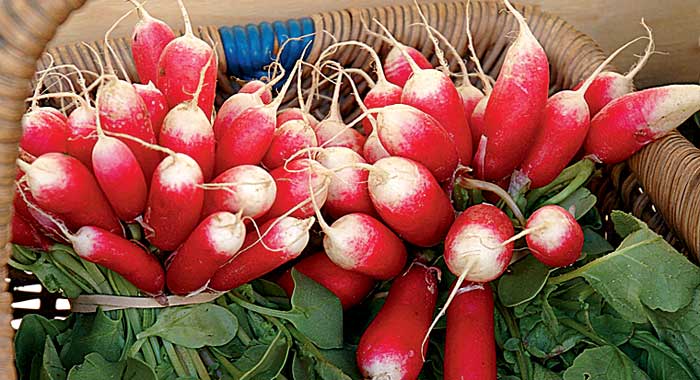
Pronounce it: rad-ish
The root of a member of the mustard family, radishes have a peppery flavour and a crisp, crunchy texture. Among the most popular varieties are the small, cherry-sized common variety which has a red skin and white flesh (the French Breakfast radish is a variation on this type, and has an elongated shape with a deep pink skin that fades to white at the roots).
You can also find black radishes, popular in eastern Europe, which are more strongly flavoured, as well as large white mooli or diakon radishes, which are shaped like carrots. They are popular in Asian cookery and have a very mild flavour.
Radishes are rich is folic acid and potassium and are a good source of vitamin B6, magnesium, riboflavin, and calcium.
Availability
All year round, though the British season runs from May to mid October. They’re extremely easy to grow from seed, whether in an allotment or in a window box. Find out more about growing radishes at Garden Action.
Choose the best
Go for firm-skinned radishes, with no blemishes. If they feel soft, they are likely to be spongy inside. Any greens still attached should look fresh and perky. The bigger the radish, the less crisp its texture, so avoid larger examples.
Prepare it
To increase the crispness of radish, soak them in iced water for a couple of hours. Wash, then chop off the greens, if present, then slice off the root. Leave whole, slice or chop, as required.
Always prepare radishes just before using, as they loose their potency when cut. Mooli or daikon radishes can be sliced, diced or grated.
Store it
In a perforated bag in the fridge for around 3-4 days. Always trim the leaves off before storing, as they’ll draw moisture from the radish itself. You can keep the radish greens in the fridge, wrapped in moist kitchen paper then stowed in a perforated bag, for a couple of days.
Cook it
Common red-skinned: raw in salads. Mooki or daikon: raw or stir-fried (3 minutes). Add radish greens to salads.
Alternatives
Try cucumber.
Be the first to comment on "Radish"